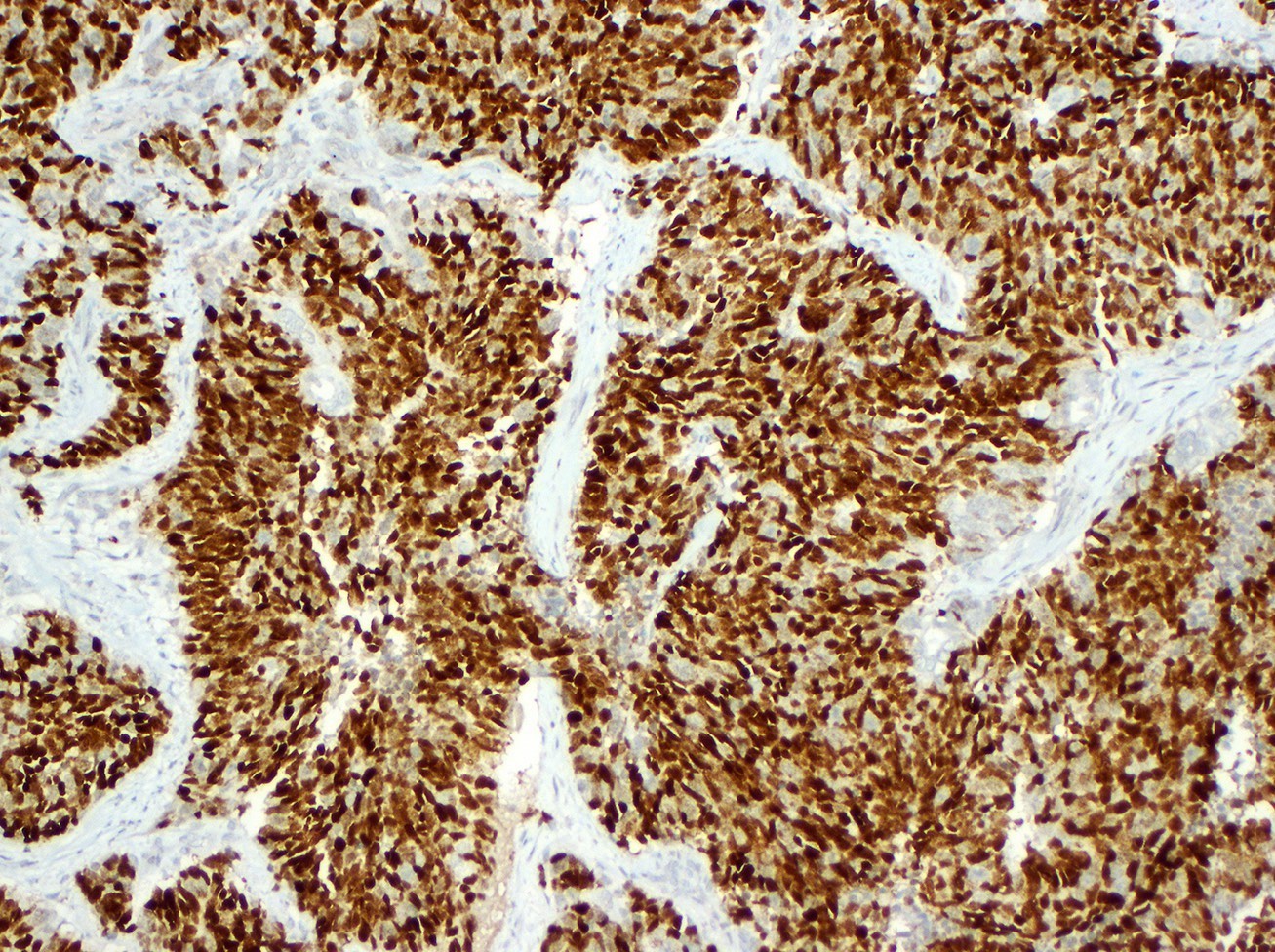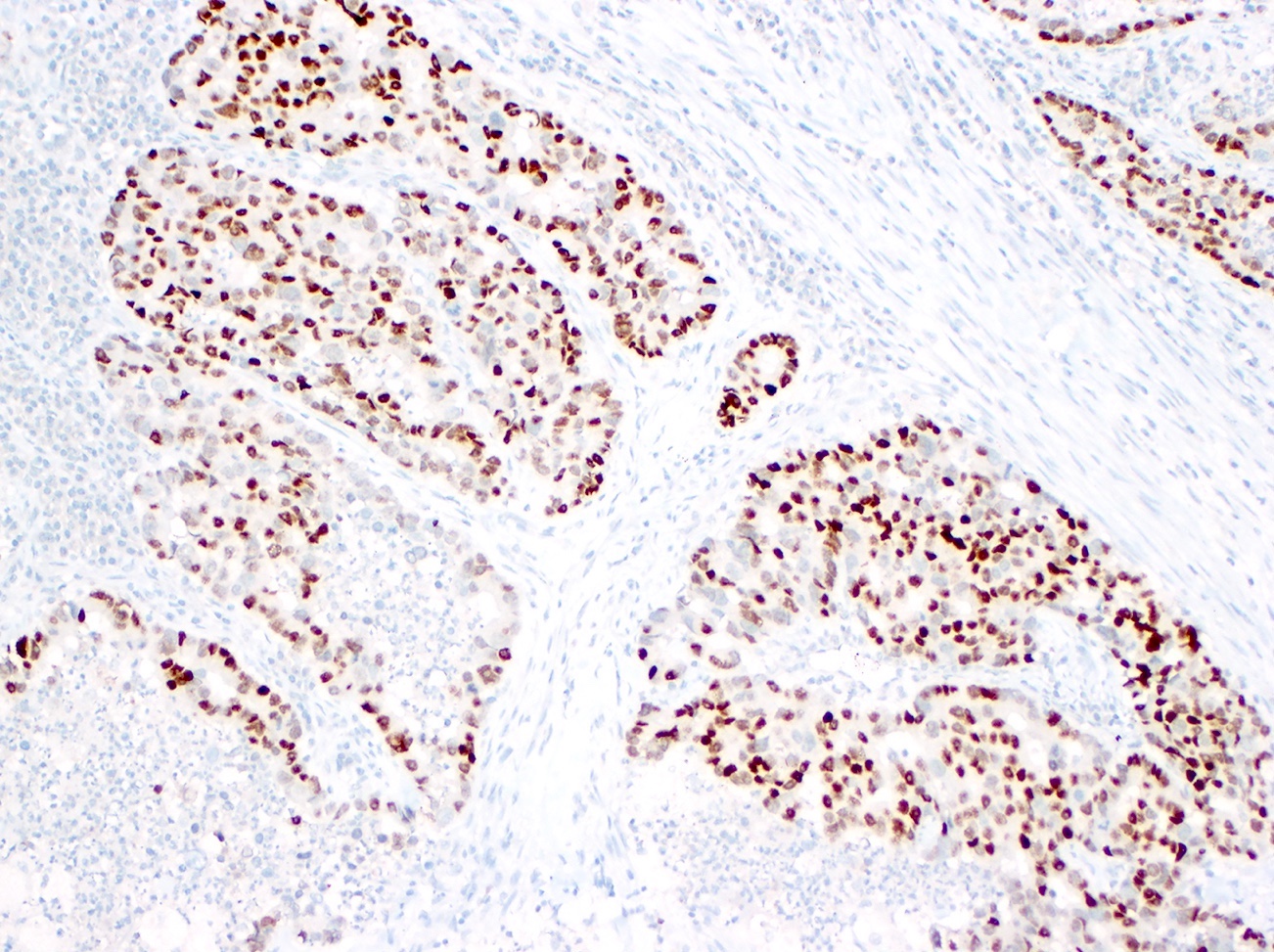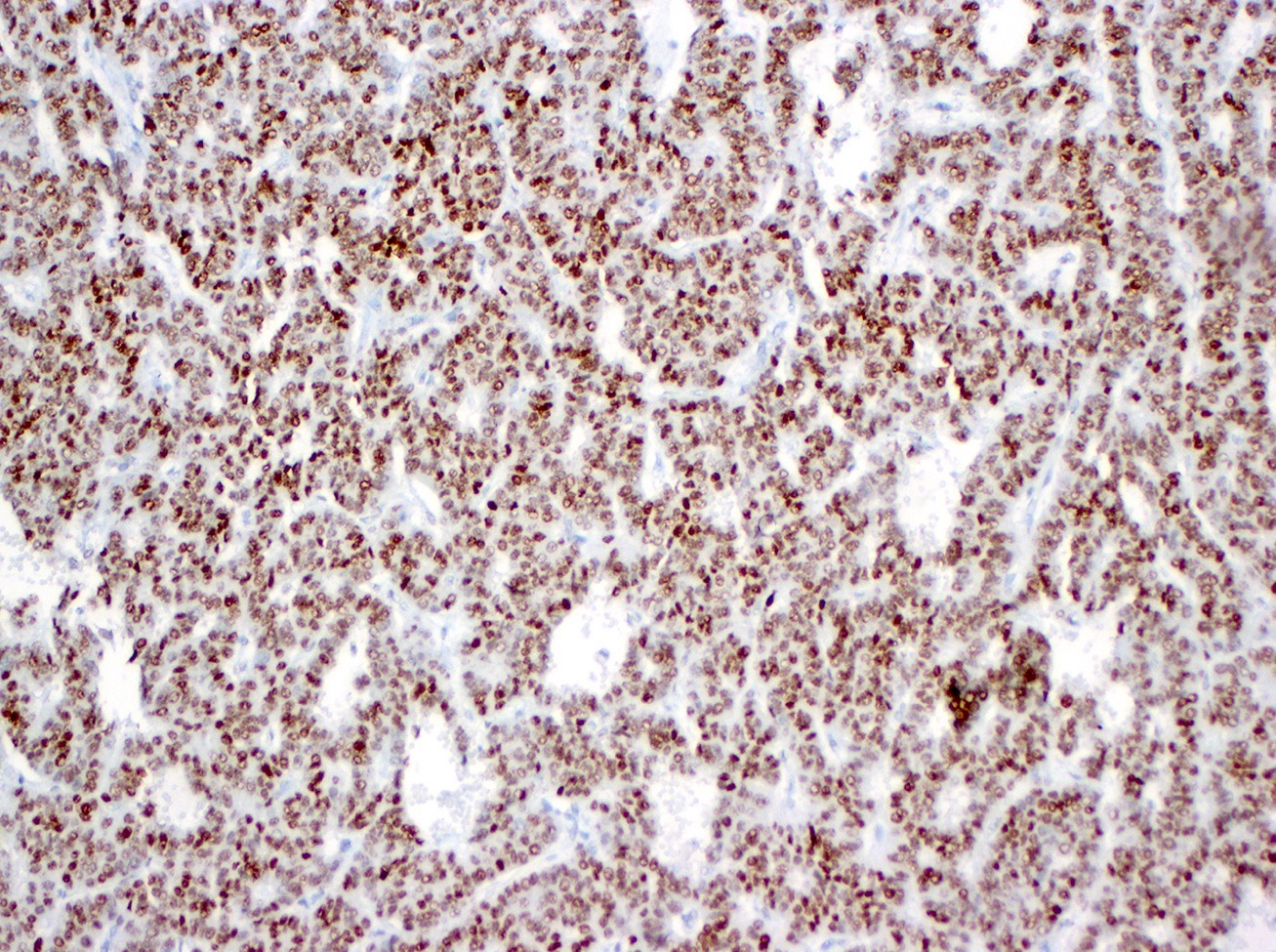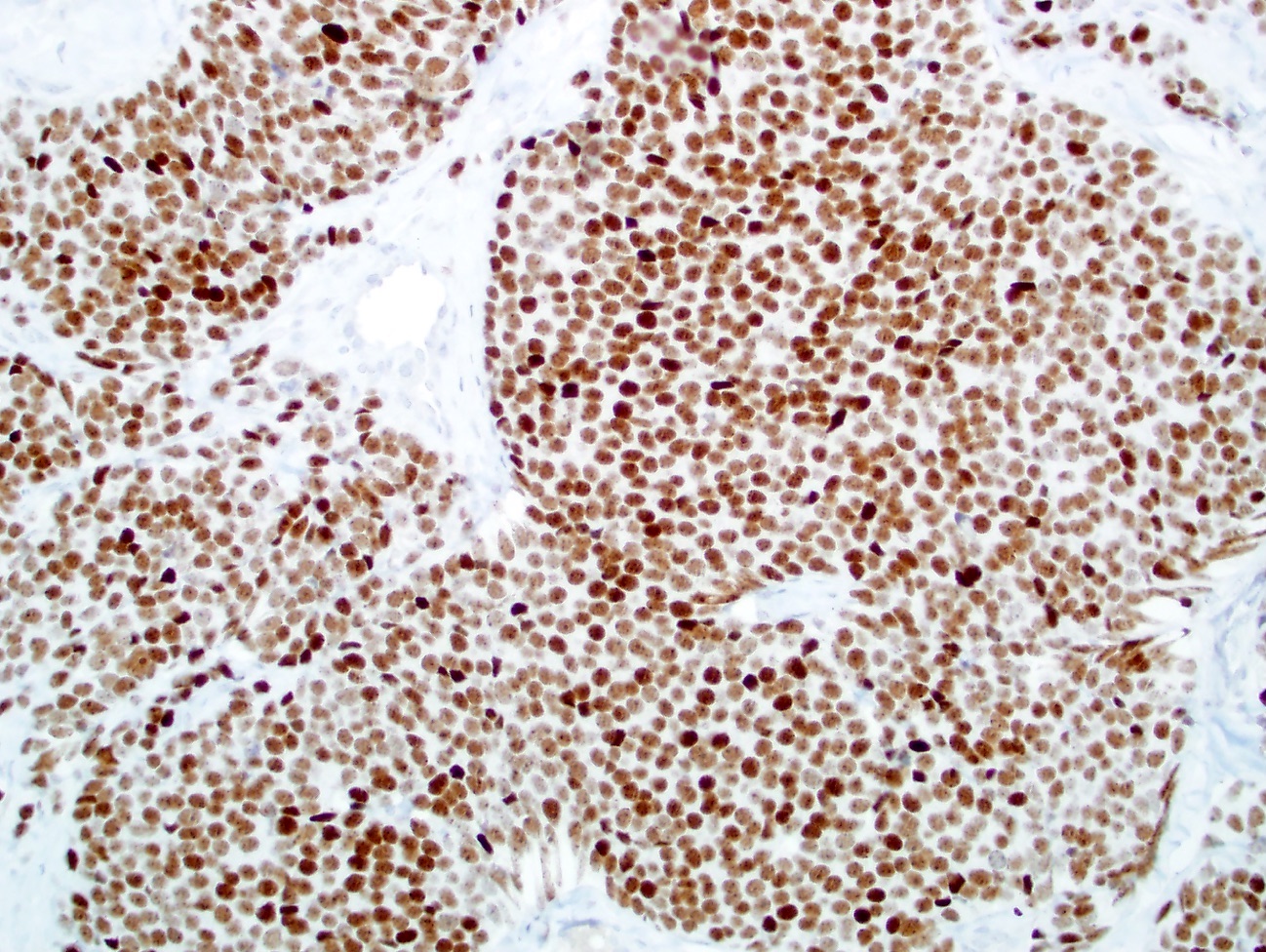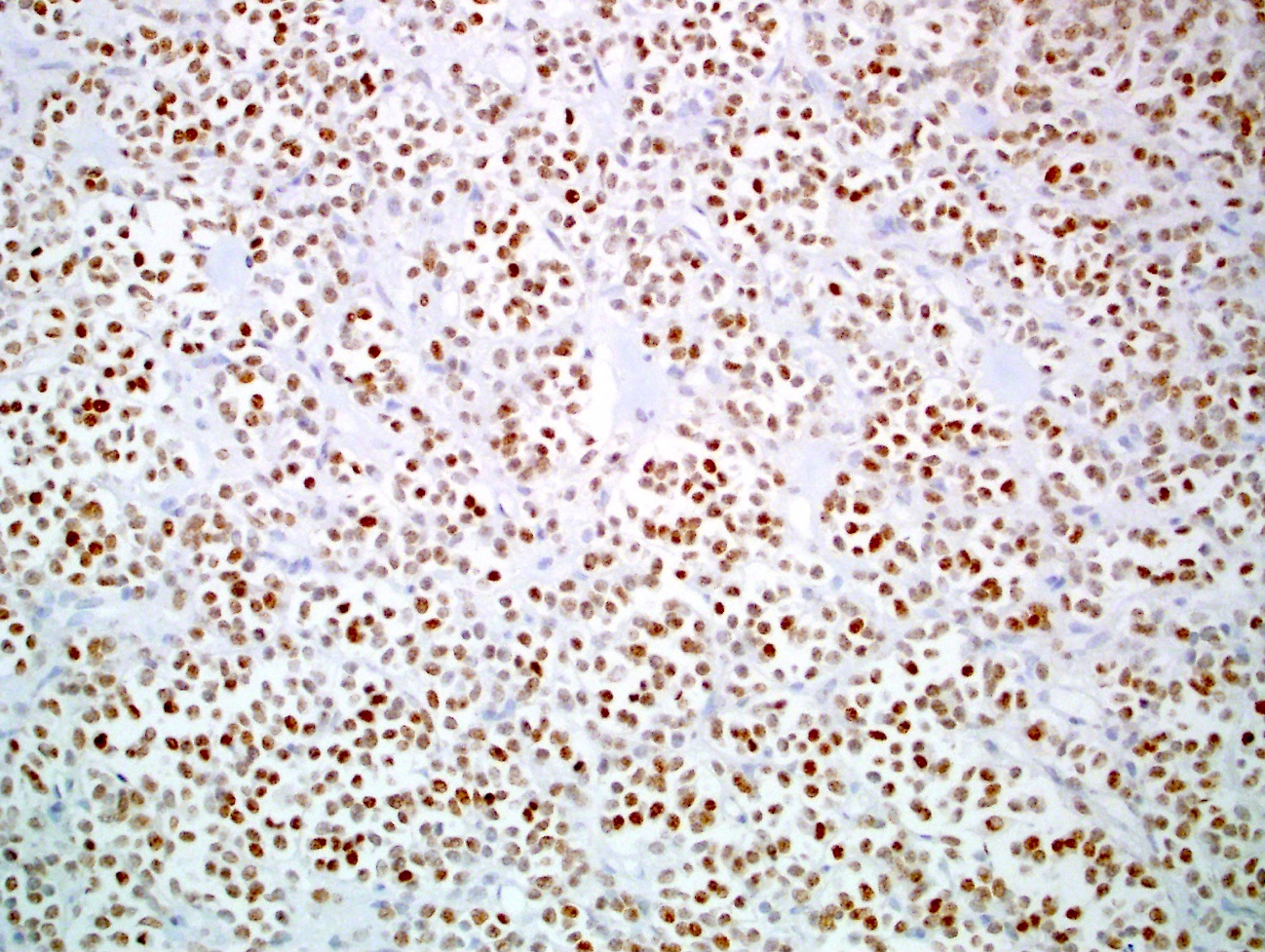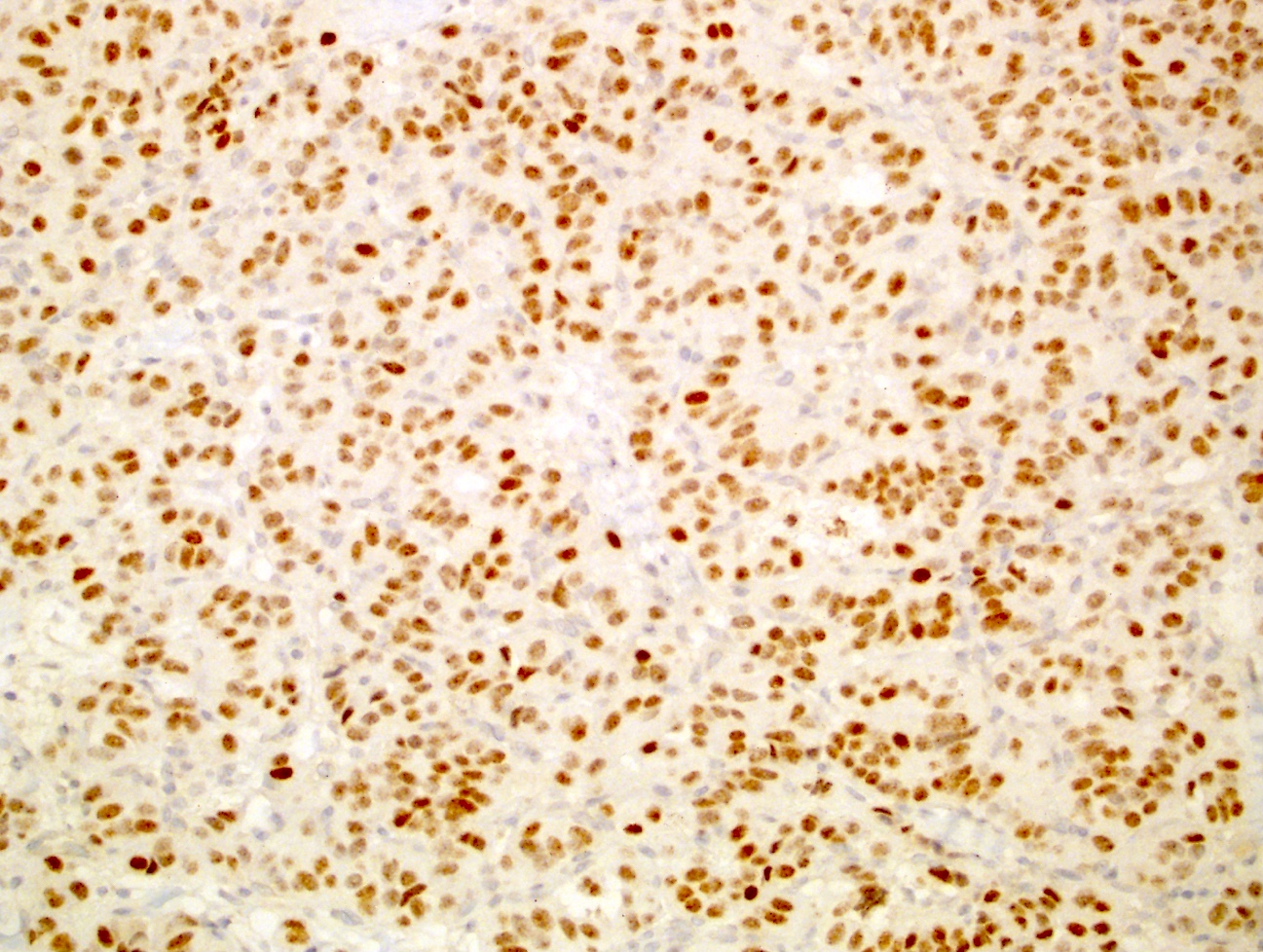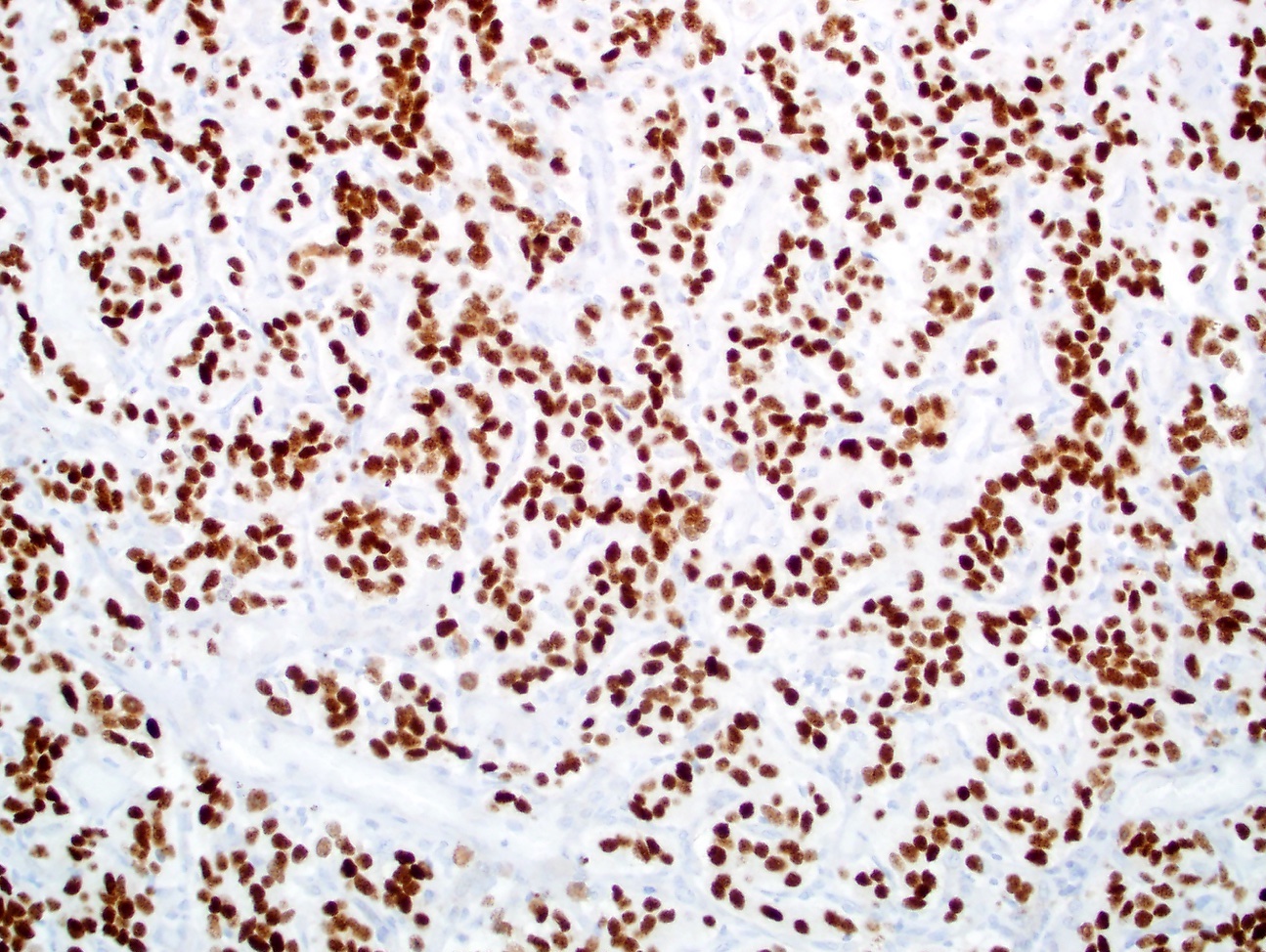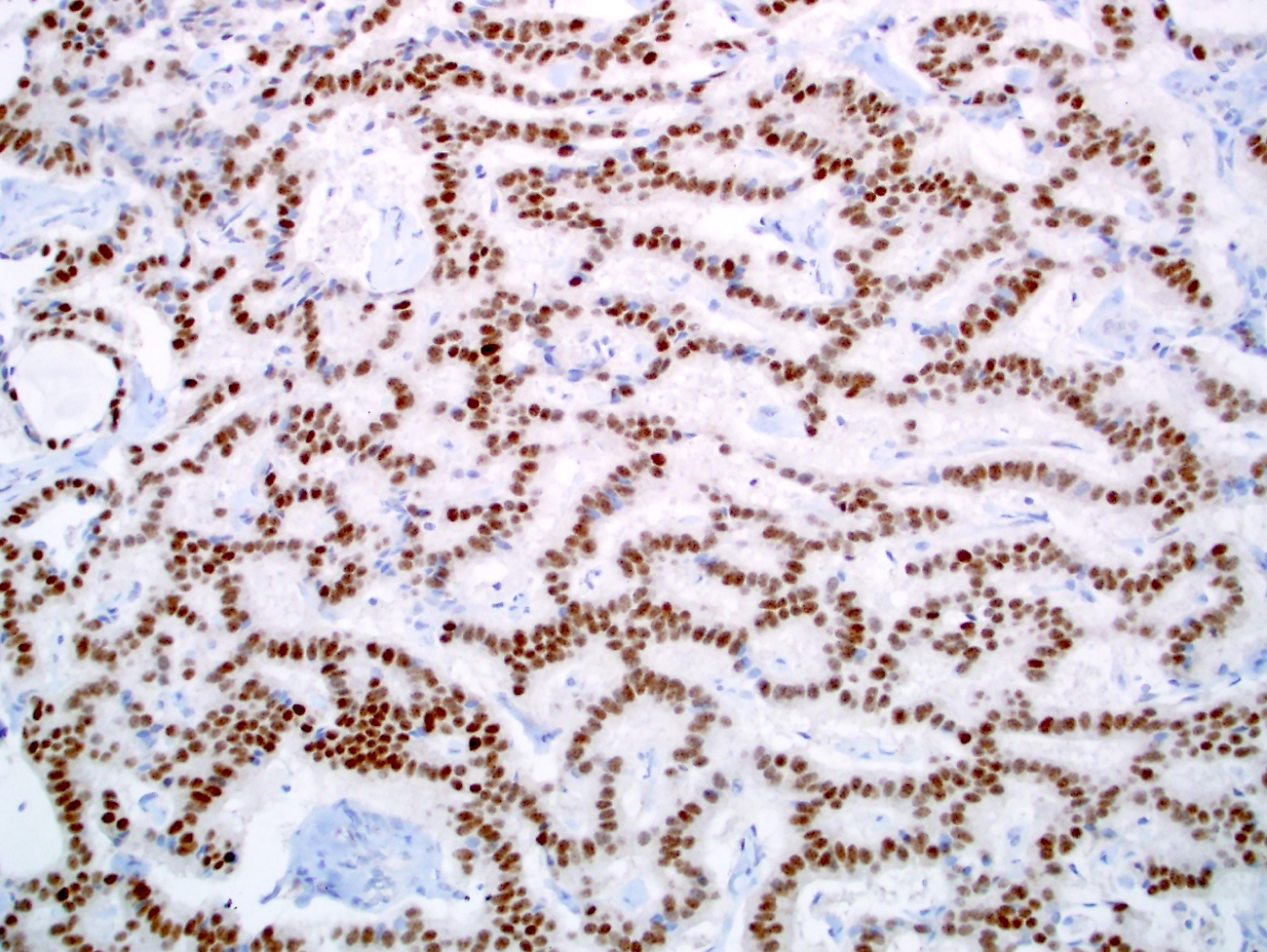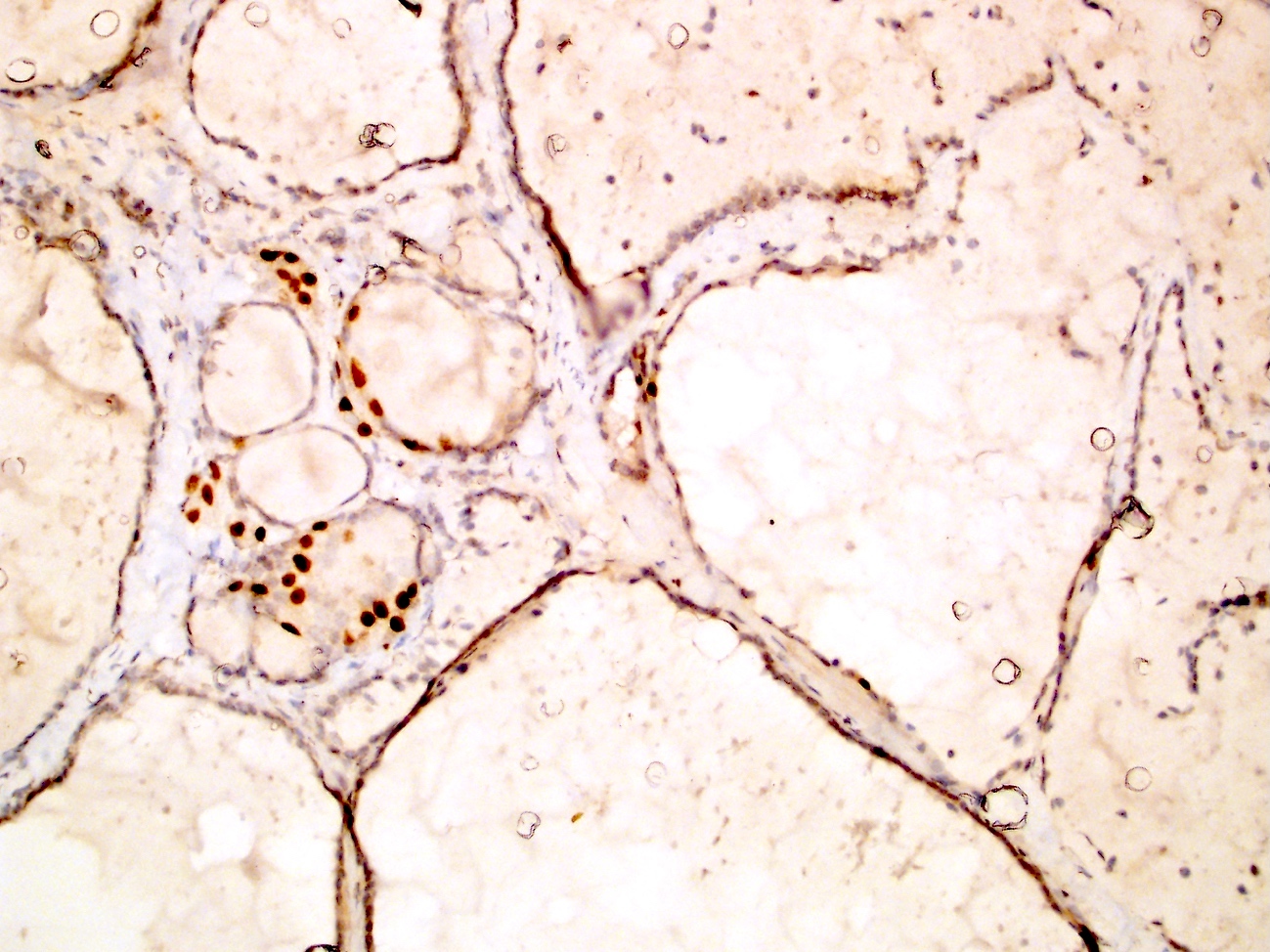Table of Contents
Definition / general | Essential features | Pathophysiology | Clinical features | Uses by pathologists | Prognostic factors | Interpretation | Microscopic (histologic) images | Positive staining - normal | Positive staining - tumors | Negative staining - normal | Negative staining - tumors | Board review style question #1 | Board review style answer #1Cite this page: Rooper LM INSM1. PathologyOutlines.com website. https://www.pathologyoutlines.com/topic/stainsINSM1.html. Accessed April 23rd, 2024.
Definition / general
- Insulinoma associated protein 1
- Previously abbreviated as IA1
Essential features
- Nuclear marker of neuroendocrine differentiation with equivalent or better sensitivity and specificity compared to synaptophysin, chromogranin and CD56
- Expressed in a broad spectrum of neuroendocrine tumors (including small cell carcinoma, large cell neuroendocrine carcinoma and well differentiated neuroendocrine tumor / carcinoid tumor of various sites, paraganglioma / pheochromocytoma, Merkel cell carcinoma, olfactory neuroblastoma and medullary thyroid carcinoma)
- Also expressed in normal adult neuroendocrine tissues (adrenal medulla, pineal gland, pituitary gland, gastrointestinal enterochromaffin cells, pancreatic islet cells, thyroid C cells) and developing neurons
Pathophysiology
- Zinc finger transcription factor originally isolated from pancreatic insulinomas (J Biol Chem 1992;267:15252)
- Transcriptional repressor that regulates entry into cell cycle and controls expression of neuroendocrine phenotype in normal tissues (Biochem J 2006;397:169, J Biol Chem 2009;284:5574)
- Plays a vital role in development of normal neuroendocrine cells throughout body (Genes Dev 2006;20:2465, Development 2008;135:473, J Comp Neurol 2008;507:1497, Neural Dev 2011;6:6)
- Regulates the development of neuroendocrine differentiation in various tumor types (Am J Pathol 2015;185:3164)
Clinical features
- Proposed as promoter for targeted gene therapy for small cell lung carcinoma (Cancer Gene Ther 2006;13:375)
Uses by pathologists
- Identification of neuroendocrine differentiation in a wide range of tissues and tumor types (Am J Clin Pathol 2015;144:579)
- Diagnosis of high grade neuroendocrine carcinoma that is negative for synaptophysin and chromogranin (Am J Surg Pathol 2017;41:1561, Am J Surg Pathol 2018;42:665)
- Identification of immature neuronal differentiation in brain tumors and developing brain tissue (J Neuropathol Exp Neurol 2018;77:374)
- Differentiates carcinoid tumorlet from pulmonary meningothelial-like nodule (Histopathology 2018;72:1067)
- Differentiates extraskeletal myxoid chondrosarcoma from most histologic mimics (Mod Pathol 2018;31:744)
Prognostic factors
- High expression of INSM1 is associated with increased progression free survival and chemosensitivity in small cell lung carcinoma (Oncotarget 2017;8:73745)
- Higher expression in midgut gastrointestinal neuroendocrine carcinomas with metastases compared to those not yet metastasized (Am J Clin Pathol 2015;144:579)
Interpretation
- Nuclear stain
Microscopic (histologic) images
Positive staining - normal
- Adrenal: medulla (Am J Clin Pathol 2015;144:579)
- Brain: pineal gland, pituitary gland, developing neurons in external granular cell layer of fetal cerebellum and subventricular zones (J Neuropathol Exp Neurol 2018;77:374)
- Gastrointestinal tract: enterochromaffin cells (Am J Clin Pathol 2015;144:579)
- Pancreas: islet cells (Am J Clin Pathol 2015;144:579)
- Thyroid: C cells (Am J Surg Pathol 2018;42:665)
Positive staining - tumors
- Adrenal: pheochromocytoma (100%), neuroblastoma (75%) (Am J Clin Pathol 2015;144:579)
- Brain: medulloblastoma (87%), central neurocytoma (100%), pituitary adenoma (100%), pineal parenchymal tumor (43%), CNS embryonal tumor, NOS (43%), glioblastoma (44%) (J Neuropathol Exp Neurol 2018;77:374)
- Breast: breast carcinoma with neuroendocrine differentiation (100%) (Am J Clin Pathol 2015;144:579)
- Gastrointestinal tract: gastrointestinal neuroendocrine tumors (95%), colonic adenocarcinoma with neuroendocrine differentiation (100%) (Am J Clin Pathol 2015;144:579)
- Gynecologic tract: cervical high grade neuroendocrine carcinoma (95%) (Mod Pathol 2018;31:744)
- Head and neck: small cell carcinoma (93%), large cell neuroendocrine carcinoma (100%), olfactory neuroblastoma (100%), teratocarcinosarcoma (100%), paraganglioma (100%), middle ear adenoma (100%), alveolar rhabdomyosarcoma (50%), SMARCB1 deficient sinonasal carcinoma (33%) (Am J Surg Pathol 2018;42:665)
- Lung: small cell carcinoma (95%), large cell neuroendocrine carcinoma (91%), atypical carcinoid (100%), typical carcinoid (100%) (Am J Surg Pathol 2017;41:1561)
- Mediastinum: large cell neuroendocrine carcinoma (100%), atypical carcinoid (100%) (Am J Surg Pathol 2017;41:1561)
- Pancreas: pancreatic neuroendocrine tumor (100%) (Med Mol Morphol 2018;51:32)
- Prostate: small cell carcinoma (77%) (Lab Invest 2017;97:262A)
- Skin: Merkel cell carcinoma (93%), endocrine mucin producing sweat gland carcinoma (100%) (J Cutan Pathol 2018;45:129)
- Soft tissue: extraskeletal myxoid chondrosarcoma (90%), ossifying fibromyxoid tumor (30%), Ewing sarcoma (30%), BCOR-CCNB3 sarcoma (20%) (Mod Pathol 2018;31:744)
- Thyroid / parathyroid: medullary carcinoma (100%) (Am J Surg Pathol 2018;42:665)
Negative staining - normal
- Adrenal: cortex (Am J Clin Pathol 2015;144:579)
- Brain: adult cerebellum, adult cortex (J Neuropathol Exp Neurol 2018;77:374)
- Breast: breast ductal epithelium (Am J Clin Pathol 2015;144:579)
- Gynecologic tract: endometrial glands, endometrial stroma, ovarian stroma (Am J Clin Pathol 2015;144:579)
- Lung: pneumocytes (Am J Clin Pathol 2015;144:579)
- Hematolymphoid: lymph nodes, tonsil (Am J Clin Pathol 2015;144:579)
- Pancreas: acinar epithelium, ductal epithelium (Am J Clin Pathol 2015;144:579)
- Prostate: prostate parenchyma (Am J Clin Pathol 2015;144:579)
- Skin: dermis, squamous epithelium (Am J Clin Pathol 2015;144:579)
- Soft tissue: bone, skeletal muscle, cartilage (Am J Clin Pathol 2015;144:579)
- Thyroid / parathyroid: thyroid follicular tissue, parathyroid tissue (Am J Clin Pathol 2015;144:579)
Negative staining - tumors
- Adrenal gland: adrenal cortical adenoma (0%) (Am J Clin Pathol 2015;144:579)
- Brain: ganglioglioma (7%), ependymoma (5%), pilocytic astrocytoma (0%) (J Neuropathol Exp Neurol 2018;77:374)
- Gastrointestinal tract: colonic adenocarcinoma (0%) (Am J Clin Pathol 2015;144:579)
- Head and neck: squamous cell carcinoma (2%), mucoepidermoid carcinoma (3%), adenoid cystic carcinoma (0%), polymorphous adenocarcinoma (0%), secretory carcinoma (0%), pleomorphic adenoma (0%), HPV related multiphenotypic carcinoma (0%), NUT carcinoma (0%), sinonasal undifferentiated carcinoma (0%), mucosal melanoma (0%) (Am J Surg Pathol 2018;42:665)
- Hematolymphoid: small lymphocytic lymphoma (0%) (J Cutan Pathol 2018;45:129)
- Lung: adenocarcinoma (3%), squamous cell carcinoma (4%) (Am J Surg Pathol 2017;41:1561)
- Pancreas: ductal adenocarcinoma (0%), acinar cell carcinoma (0%), solid pseudopapillary neoplasm (0%) (Med Mol Morphol 2018;51:32)
- Prostate: adenocarcinoma (9%) (Lab Invest 2017;97:262A)
- Skin: melanoma (0%) (Am J Clin Pathol 2015;144:579)
- Soft tissue: chondrosarcoma (0%), chordoma (10%), myxofibrosarcoma (0%), myxoid liposarcoma (0%), intramuscular mxyoma (0%), low grade fibromyxoid sarcoma (0%), myoepithelioma (5%), angiomatoid fibrous histiocytoma (0%), dedifferentiated liposarcoma (0%), CIC rearranged sarcoma (0%), synovial sarcoma (0%) (Mod Pathol 2018;31:744)
- Thyroid / parathyroid: papillary carcinoma (0%), follicular carcinoma (0%), follicular adenoma (0%), parathyroid carcinoma (0%), parathyroid adenoma (0%) (Am J Surg Pathol 2018;42:665)
Board review style question #1
Which of the following tumors should be negative for INSM1?
- Extraskeletal myxoid chondrosarcoma
- Middle ear adenoma
- Parathyroid adenoma
- Small cell carcinoma of the uterine cervix
- Well differentiated pancreatic neuroendocrine tumor, grade 1
Board review style answer #1
C. Parathyroid adenoma. Although parathyroid neoplasms frequently stain with the common neuroendocrine stain chromogranin, they are consistently negative for INSM1.
Comment Here
Reference: INSM1
Comment Here
Reference: INSM1




